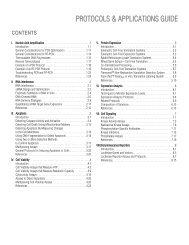pHTC HaloTag CMV-neo Vector Product Information ... - Promega
pHTC HaloTag CMV-neo Vector Product Information ... - Promega
pHTC HaloTag CMV-neo Vector Product Information ... - Promega
Create successful ePaper yourself
Turn your PDF publications into a flip-book with our unique Google optimized e-Paper software.
<strong>pHTC</strong> <strong>HaloTag</strong> ® <strong>CMV</strong>-<strong>neo</strong> <strong>Vector</strong> Features and Circle Map<br />
The following features are present in the <strong>pHTC</strong> <strong>HaloTag</strong> ® <strong>CMV</strong>-<strong>neo</strong> <strong>Vector</strong> based on<br />
nucleotide sequence.<br />
<strong>CMV</strong> intermediate early enhancer/promoter 1–742<br />
Chimeric intron 857–989<br />
T7 RNA polymerase promoter (–17 to +3) 1033–1052<br />
Multiple cloning region 1052–1129<br />
<strong>HaloTag</strong> ® linker 1124–1168<br />
TEV protease recognition sequence 1139–1159<br />
<strong>HaloTag</strong> ® coding region 1169–2059<br />
SV40 late polyadenylation signal 2177–2398<br />
SV40 enhancer and early promoter 2497–2915<br />
SV40 minimum origin of replication 2813–2878<br />
Neomycin phophotransferase coding region 2960–3754<br />
Synthetic polyadenylation signal 3818–3866<br />
β-lactamase (Ampr ) coding region 4127–4987<br />
ColE1-derived plasmid origin of replication 5142–5178<br />
ori<br />
Synthetic poly(A)<br />
signal<br />
Amp r<br />
<strong>pHTC</strong> <strong>HaloTag</strong> ® <strong>CMV</strong>-<strong>neo</strong><br />
<strong>Vector</strong><br />
(6185bp)<br />
Neo r<br />
<strong>CMV</strong> Enhancer/<br />
Promoter<br />
intron<br />
SV40 Early<br />
Enhancer/<br />
Promoter<br />
T7<br />
TEV<br />
site<br />
SV40 Late<br />
poly(A)<br />
NheI 1053<br />
BmtI 1057<br />
SgfI 1066<br />
PvuI 1066<br />
EcoRI 1074<br />
SacII 1086<br />
EcoRV 1090<br />
XbaI 1092<br />
PspOMI 1101<br />
ApaI 1105<br />
SbfI 1116<br />
EcoICRI 1122<br />
SacI 1124<br />
XhoI 1125<br />
<strong>HaloTag</strong> ® Open<br />
Reading Frame<br />
Figure 1. <strong>pHTC</strong> <strong>HaloTag</strong> ® <strong>CMV</strong>-<strong>neo</strong> <strong>Vector</strong> circle map and sequence reference points.<br />
NheI BmtI<br />
SgfI<br />
PvuI<br />
EcoRI SacII<br />
Usage <strong>Information</strong><br />
EcoRV<br />
XbaI<br />
5´– GCT AGC AAA GCG ATC GCT TCC GAA TTC CTA CCG CGG ATA TCT AGA<br />
A S K A I A S E F L P R I S R<br />
PspOMI<br />
ApaI<br />
SbfI<br />
EcoICRI<br />
SacI<br />
XhoI<br />
TTT GGG CCC AAT TCC TGC AGG CGA GCT CTC GAG –3´<br />
F G P N S C R R A L E<br />
Figure 2. <strong>pHTC</strong> <strong>HaloTag</strong> ® <strong>CMV</strong>-<strong>neo</strong> <strong>Vector</strong> multiple cloning region sequence and unique<br />
restriction sites. The amino acid sequence corresponds to the correct reading frame for the<br />
<strong>HaloTag</strong> ® coding region.<br />
9854MA<br />
I. Extraction Protocol for the <strong>HaloTag</strong> ® <strong>Vector</strong> Card<br />
Materials to be Supplied by User<br />
extraction buffer [10mM Tris (pH 8.0), 20mM NaCl]<br />
E. coli competent cells for transformation (see Section III for suggestions)<br />
1. Cut the vector card on the dotted lines and aseptically remove the filter paper square<br />
containing the dried <strong>HaloTag</strong> ® <strong>Vector</strong> DNA (see the QuickTime video for a<br />
demonstration at: www.halotag.com).<br />
2. Transfer the filter paper to a 1.5ml centrifuge tube (e.g., using sterile forceps).<br />
3. Add 30µl of extraction buffer, vortex and briefly centrifuge.<br />
4. Ensure that the filter paper is submerged in the buffer, and incubate for 30 minutes at<br />
room temperature. Vortex sample.<br />
5. Transform 2–10µl of the extracted vector DNA into competent cells, following<br />
manufacturer’s instructions for the competent cells. Store unused DNA at –20°C.<br />
6. Plate the cells on media with Ampr selection, dispensing 2–20% of the<br />
transformation reaction volume.<br />
Note: We recommend working with each vector (N-terminal and C-terminal)<br />
separately to minimize the risk of cross-contamination.<br />
II. Troubleshooting<br />
Symptoms Solutions<br />
Poor transformation Check the competent cells. If necessary, make or purchase<br />
fresh cells.<br />
Check for proper antibiotic selection. Use ampicillin or<br />
carbenicillin to select for the Ampr vector.<br />
Plate a larger volume of the transformation reaction;<br />
if necessary, pellet the transformed cells and resuspend in<br />
100µl of medium. Plate all of the transformed cells.<br />
Dry down the volume of extracted DNA to 5µl and transform.<br />
Note about electroporation<br />
The extraction buffer contains 20mM NaCl, which may be incompatible with<br />
electroporation. Before proceeding with electroporation, ethanol precipitate the vector<br />
DNA from extraction buffer and resuspend in buffer without salt.<br />
III. Related <strong>Product</strong>s<br />
<strong>Product</strong> Size Cat.#<br />
JM109 Competent Cells, >10 8cfu/µg 5 × 200µl L2001<br />
JM109 Competent Cells, >10 7 cfu/µg 5 × 200µl L1001<br />
HB101 Competent Cells, >10 8cfu/µg 5 × 200µl L2011<br />
<strong>HaloTag</strong> ® Mammalian Protein Detection and<br />
Purification System 1 each G6795<br />
<strong>HaloTag</strong> ® Mammalian Pull-Down and Labeling System 24 reactions G6500<br />
HaloCHIP System 20 reactions G9410<br />
Part# GE445<br />
Printed in USA 3/11<br />
<strong>Promega</strong> Corporation · 2800 Woods Hollow Road·Madison, WI 53711-5399 U.S.A. · Toll Free in the USA 800-356-9526 · Telephone 608-274-4330 · www.promega.com<br />
9852MA

















